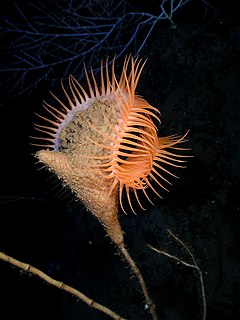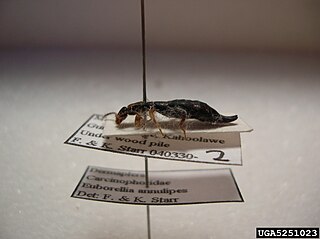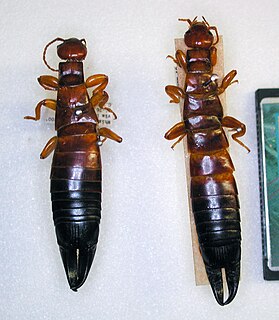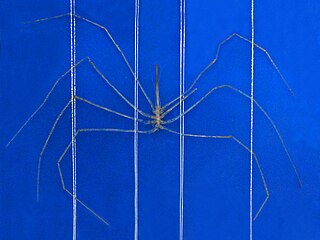A genus is a taxonomic rank used in the biological classification of living and fossil organisms, as well as viruses, in biology. In the hierarchy of biological classification, genus comes above species and below family. In binomial nomenclature, the genus name forms the first part of the binomial species name for each species within the genus.

Earwigs make up the insect order Dermaptera. With about 2,000 species in 12 families, they are one of the smaller insect orders. Earwigs have characteristic cerci, a pair of forceps-like pincers on their abdomen, and membranous wings folded underneath short, rarely used forewings, hence the scientific order name, "skin wings." Some groups are tiny parasites on mammals and lack the typical pincers. Earwigs are found on all continents except Antarctica.

Endemism is the ecological state of a species being native to a single defined geographic location, such as an island, nation, country or other defined zone, or habitat type; organisms that are indigenous to a place are not endemic to it if they are also found elsewhere. For example, the orange-breasted sunbird is exclusively found in the fynbos vegetation zone of southwestern South Africa and the glacier bear is endemic to Southeast Alaska. The extreme opposite of an endemic species is one with a cosmopolitan distribution, having a global or widespread range. An alternative term for a species that is endemic is precinctive, which applies to species that are restricted to a defined geographical area.

Colossendeidae is a family of sea spider.
Dr William Thomas Calman was a Scottish zoologist, specialising in the Crustacea. From 1927 to 1936 he was Keeper of Zoology at the British Museum.
Giant earwig may refer to any of the following species of earwigs, all in the suborder Forficulina:

The Venus flytrap sea anemone is a large sea anemone that superficially resembles a Venus flytrap. It closes its tentacles to capture prey or to protect itself. It is a deep ocean species.
Diplogyniidae is a family of parasitic mites belonging to the order Mesostigmata. Many are parasites on beetles but some live on larger animals.

Halichondria is a genus of sea sponges belonging to the family Halichondriidae. These are massive, amorphous sponges with clearly separated inner and outer skeletons consisting of bundles of spicules arranged in a seemingly random pattern.

An endangered species is a species that is very likely to become extinct in the near future, either worldwide or in a particular political jurisdiction. Endangered species may be at risk due to factors such as habitat loss, poaching and invasive species. The International Union for Conservation of Nature (IUCN) Red List lists the global conservation status of many species, and various other agencies assess the status of species within particular areas. Many nations have laws that protect conservation-reliant species which, for example, forbid hunting, restrict land development, or create protected areas. Some endangered species are the target of extensive conservation efforts such as captive breeding and habitat restoration.

The largest organisms now found on Earth can be determined according to various aspects of an organism's size, such as: mass, volume, area, length, height, or even genome size. Some organisms group together to form a superorganism, but such are not classed as single large organisms. The Great Barrier Reef is the world's largest structure composed of living entities, stretching 2,000 km (1,200 mi), but contains many organisms of many types of species.

In zoology, deep-sea gigantism, also known as abyssal gigantism, is the tendency for species of invertebrates and other deep-sea dwelling animals to be larger than their shallower-water relatives. Proposed explanations for this type of gigantism include colder temperature, food scarcity, and reduced predation pressure in the deep sea. The inaccessibility of abyssal habitats has hindered the study of this topic.
In biology, a species is the basic unit of classification and a taxonomic rank of an organism, as well as a unit of biodiversity. A species is often defined as the largest group of organisms in which any two individuals of the appropriate sexes or mating types can produce fertile offspring, typically by sexual reproduction. Other ways of defining species include their karyotype, DNA sequence, morphology, behaviour or ecological niche. In addition, paleontologists use the concept of the chronospecies since fossil reproduction cannot be examined.

Anisolabididae is a family of earwigs, in the suborder Forficulina and the order Dermaptera. It is one of nine families in the suborder Forficulina, and contains thirty-eight genera spread across thirteen subfamilies.

Titanolabis is a genus of earwigs in the subfamily Anisolabidinae. It was cited by Srivastava in Part 2 of Fauna of India. Among its species is the Australian T. colossea, which at about 5 cm (2.0 in) long is the largest certainly living species of earwig.
Collyris is a genus of tiger beetles in the family Carabidae. Species are found in Asia. The genus contains the following species:

Colossendeis is a genus of sea spider belonging to the family Colossendeidae.











